Highlight the beauty of your Ghost Angelfish even when it’s hiding from prying eyes. Learn the best care practices for protecting its translucent skin and delicate fins.
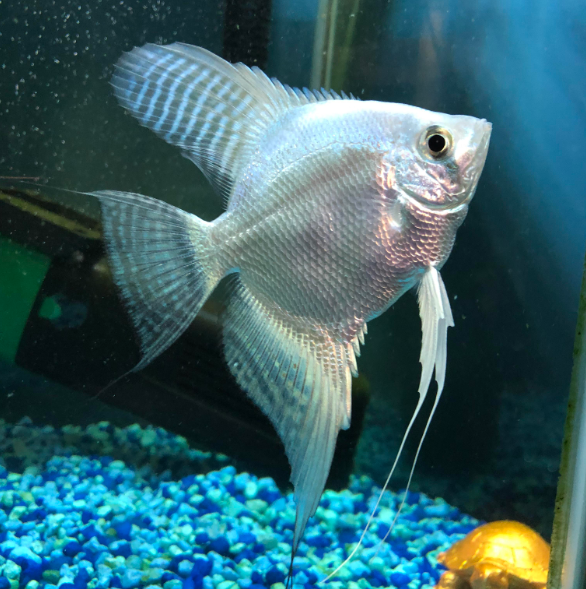
Exploring the Ghost Angelfish
Almost every aquarium enthusiast and hobbyist these days has an exotic freshwater fish in their tank, and if you’re here, it’s because you’ve joined the wave. Today, I’ll highlight a translucent aquarium fish that’s worth a second, third, and as many looks as you can spare!
The Ghost Angelfish has a mysterious allure because of its unique physical features and genetics. This captivating aquarium species has the body of a regular angelfish, but its genetics make it appear almost transparent or, as the early breeders said, a ghost.
Despite being almost invisible, this variant makes an interesting addition to any tank. This complete care guide gives you all the Ghost Angelfish Essentials you need to keep your pet healthy.
Origins and Unique Genetics
To know the Ghost Angelfish’s Origins, you must first understand the history of the Angelfish. Angelfish are cichlids that naturally grow in the South American Orinoco Basin and the Guiana Shield.
In the late 20th Century, fish traders experimented with genetic breeding to create more beautiful Angelfish variants to get an edge over each other in the open market.
As they worked towards the development of ghost variety, these breeders stumbled on new colorations that took the aquatic world by storm! And as mentioned, amongst their Angelfish selective breeding discoveries came the unique Ghost Angelfish.
Distinctive Physical Traits

The Ghost Angelfish’s appearance is the first thing that captivates aquarist about this species. Its subtle coloration, which is a combination of a translucent white or silver body with rare gold or reddish patches on its head, earned it the name Ghost.
However, there’s more to this species than its ghostly fish appearance, as you’ll learn. Other physical attributes include its triangular body with long flowing fins. Its lateral compressed body extends between 6 – 8 inches with its pectoral, dorsal, and anal fins. Now, combine its translucent color with its elegant physical structure, and what do you get? A graceful aquarium fish that glides through water incognito.
Specialized Care Practices
Preserving the Ghost Angelfish’s semi-transparent body and protecting its sensitive physical traits requires delicate fish care. These specialized practices include maintaining water quality and following strict tank requirements.
Suitable Water Quality for Ghost Angelfish
As a freshwater species, Ghost Angelfish thrives in slightly acidic water with a pH level of 6.8 – 7.8 and a temperature of 78 – 82℉. Add a good filtration system to help the Nitrogen cycle by converting harmful waste (ammonia) to adequate beneficial bacteria, nitrite, and nitrate. Change 25 – 30% of your tank water weekly, especially if you have a smaller aquarium.
That’s not the end of your Ghost Angelfish Care, though. After sorting your water quality, you must create the ideal habitat to ensure your pet has the best conditions for growth, health, and social interaction.
Creating the Ideal Habitat
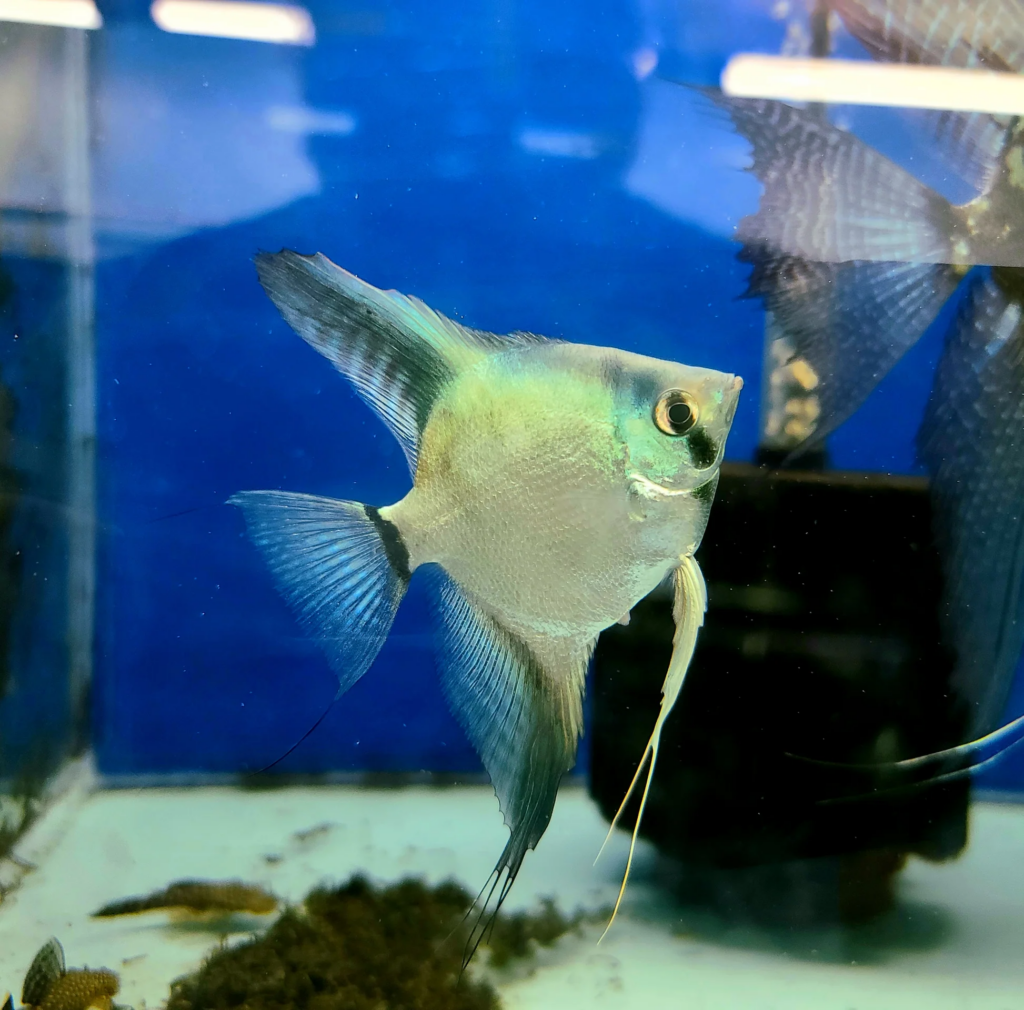
Although the Ghost Angelfish loves its anonymity, you can spotlight its presence by decorating its habitat to complement its coloration. If you need inspiration, look to its origins and history for the ideal Ghost Angelfish Habitat.
All you need to do is downsize the vast South America Orinoco Basin into your 35 – 55 gallon tank. Here are some tips to help you —
Tank Size
A 35 – 55 gallon tank is the standard size for a small group of Ghost Angelfish, but you can go smaller or bigger depending on your budget. The least tank size for a single Ghost Angelfish is 20 gallons of water in a tall tank to suit its triangular body.
Substrate
Here’s where you use your knowledge of aquarium setup for delicate fish because you want to protect your pets while enhancing tank aesthetics.
Use soft substrates like sand, fine gravel, or smooth pebbles for the base. It’s kind on their skin while reminding your pets of their natural habitat.
Decor
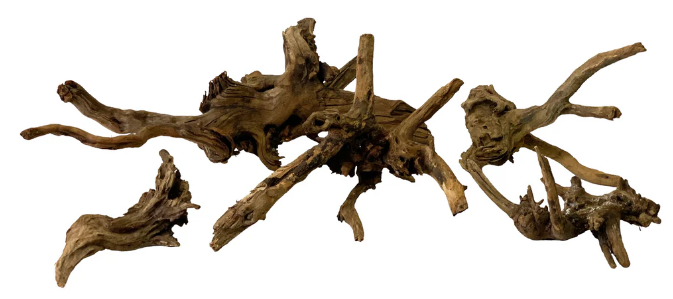
You can add natural or artificial plants in your fish tank to mimic the Amazons. Also, smooth rocks and driftwood should be put in place to give the Ghost Angelfish a hiding spot when it feels overwhelmed by attention or overstimulated from activity.
Lighting
Use a light that has a timer functionality to create a night-to-day cycle and give your Ghost Angelfish a routine. The low light is to encourage this shy species to move around without worrying about scrutiny. Also, bright lights can burn their translucent scales, so ensure they have plants or other decor that they can use for shade.
Overall, it would be best if you created a stress-free environment for Angelfish, no matter the variant, because they get agitated in crowded tanks and when fighting for food.
For more on lighting check out our article on the Best LED Lighting for Aquariums by depth!
Feeding and Dietary Needs
Feeding Ghost Angelfish is easy since this species eats plant and live foods, making them omnivorous. They have regular Angelfish dietary needs, which you can classify into primary and supplemental foods.
For primary food, you can feed your Ghost Angelfish with processed high-quality flakes, pellets, and fiber while live, freeze-dried, and frozen foods are supplements. Examples of supplemental foods include Brine Shrimp, Bloodworms, and Daphnia.
When choosing processed commercial food, ensure it has enough nutrition for delicate fish, such as carotenoids for its skin coloration and Vitamins for fin development.
For more on feeding your aquatic pets check out The Ultimate Guide to Fish Food: Pros and Cons & Best Choices!
Feeding Frequency and Portion Control
If your pet struggles with indigestion, it’s because of overfeeding or poor-quality foods. To avoid that, ensure you only feed the Ghost Angelfish twice daily in portions consumable under 3 minutes.
To resolve indigestion, add vegetable matter like blanched, peeled peas, zucchini, and algae to their diet after a day of fasting. Now, let’s discuss other health issues your Ghost Angelfish may experience.
Health Monitoring and Disease Prevention
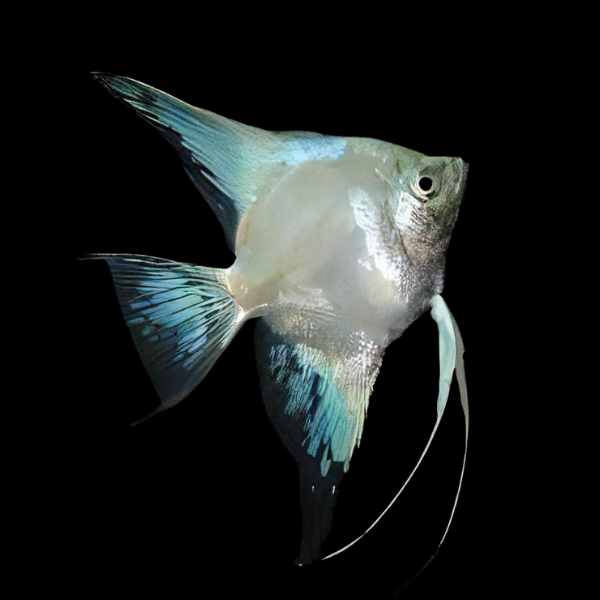
Health monitoring is only useful if you know the signs of illnesses and any other irregularities in your pet’s lifestyle. That’s why I started this guide by giving you a preview of the Ghost Angelfish’s physical appearance, personality, and dietary needs.
Knowing those details, you can use these tips for recognizing signs of distress, treatments for immediate recovery, and preventing diseases.
- Check their appearance for discoloration and fin damage.
- Test the water for irregular parameters.
- Notice behavioral changes like aggression, uncomfortable swimming, and overexcitement.
These are some of the diseases, their symptoms, and more tips on treating Angelfish diseases:
Ich (White Spot)
Symptoms: Grainy salty spots
Cause: Parasitic Infection
Treatment: Anti-parasitic medication
Fin Rot
Symptoms: Fraying and Discoloration of Fins
Cause: Bacterial infection
Treatment: Anti-bacterial treatment
For more details checkout our article on How to Treat Ich Outbreaks in Your Freshwater Fish!
Dropsy
Symptoms: Raised scales, Swelling of Body, Laziness in Swimming
Cause: Internal Disease
Treatment: Antibiotics
The best preventive measures for your Ghost Angelfish health is to follow all care requirements to the letter. That includes dietary needs, water parameters, tank needs, and tank mates.
Breeding Insights
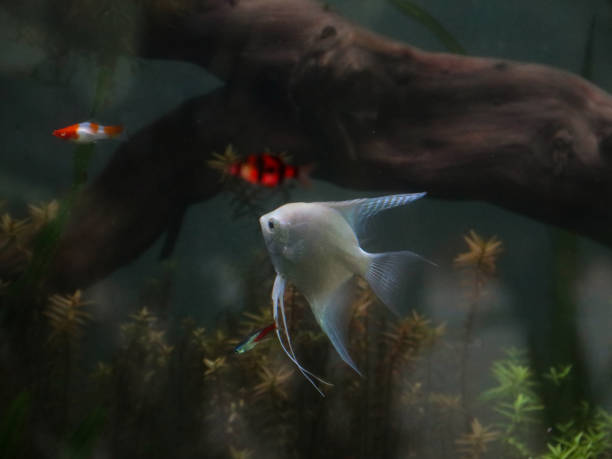
If you love everything you’ve read about the Ghost Angelfish so far and can’t wait to add more of them to your tank, here are some breeding insights. Successful Angelfish breeding has slightly different requirements from keeping adult pets, but it’s doable.
Here, I’ll highlight some Angelfish reproduction challenges with practical tips for overcoming them and having a thriving fry tank.
The Breeding Tank Setup
Use a separate breeding tank large enough for two adult Ghost Angelfish. So, it should hold at least 40 – 55 gallons of water. Then, ensure the hardness is soft with a regulated temperature between 78 – 80℉.
Some Angelfish spawning tips for you include using a smooth cave with plant shades to cover the spawning area and adding a flat saucer, broad leaf, or spawning mop to the substrate.
Breeding Behavior
Typically, Ghost Angelfish form pairs, but if you don’t have any natural partners, you can select healthy male and female species. The male chases the female around the tank and nudges her belly to lay eggs.
This video has been very helpful in identifying the sex of angelfish, I highly recommend it:
Once she’s ready, the female Angelfish lays her eggs on the flat surface. Then, the male fish fertilizes the eggs. After fertilization, both parents guard their eggs and fan them for oxygen.
Angelfish Fry
Within three to four days, your Ghost Angelfish eggs will hatch, and at this point, you must separate the parents from their offspring. After hatching, the Fry stays on the spawning surface and feeds on its yolk sac for survival.
By the 4th to 6th day, you must start feeding your Fry with infusoria, finely powdered food, and crushed flakes. Within a week to two weeks, they’ll become free-swimming, grow larger, and develop mouths wide enough for normal food.
Once they grow to the normal Ghost Angelfish size, you can reintegrate your pets into the main tank. But first, place them in a grow-out tank. Separate larger Fry from small ones to prevent bullying and predation.
Ghost Angelfish’s social behavior is generally reserved as they like moving in pairs and groups instead of schools. Unfortunately for lovers of community tanks, this species gets stressed in large crowds. That’s why the Angelfish’s ideal tank needs a cave for hiding.
There’s good news, though. You can encourage peaceful aquarium interactions by pairing your Ghost Angelfish with other calm, mid-water fish. Rasboras, Gouramis, and Tetras are the best tank mates for achieving any kind of successful Angelfish community dynamics.
Avoid fin-nippers and small fish that can become prey or larger fish that would become predators.
Conclusion
With this guide, you can now boast of Ghost Angelfish aquarium care mastery. Every detail on Ghost Angelfish care tips, from their nutrition and dietary needs to their health concerns, physical peculiarities, and tank mates, is here.
Surely, you no longer question this species’ capacity and potential of being your answer to enhancing aquarium mystique. You can awe your guests with its translucent body without worrying about making beginner mistakes on your Ghost Angelfish Care.
For my fellow aquatic lovers, if you have more Ghost Angelfish care tips, please share them. I’d love to hear your experiences with this alluring species.


